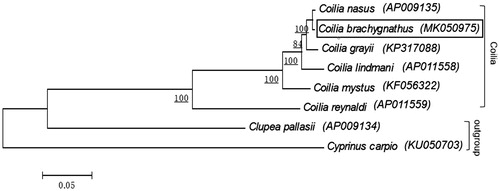Abstract
The Yangtze grenadier anchovy, Coilia brachygnathus, is a commercial fishery species in the middle and lower Yangtze River of China. Here, we describe a complete mitochondrial genome from the newly found population of C. brachygnahus in the upper Yangtze River. It was 16,857 bp in size and encodes for 2 rRNAs, 22 tRNAs, 13 protein-coding genes as well as a D-loop control region. Phylogenetic analysis confirmed the evolutionary relationship of the C. brachygnathus in the upper Yangtze to other five species of the genus Coillia. The mitochondrial genome would help to elucidate the origin of the new population of C. brachygnathus.
Coilia brachygnathu Kreyenberg et Pappenheim (1908), also called Yangtze grenadier anchovy, belongs to the genus Collia with high-economic value and mainly distributed in the Indo-Pacific region. There are 13 species in the genus Coilia worldwide, four of which are found in China. Coilia nasus, C. mystus, C. grayii, and C. brachygnathus are mainly distributed in the coastal areas and the middle and lower reaches of the Yangtze River and its adjoining lakes (Yuan et al. Citation1980). The genus Coilia generally consists of migratory fish between the river and the sea. However, C. brachygnathus is an exception which is a freshwater resident species mainly found in the tributaries and adjoining lakes of the middle and lower Yangtze River previously (Liu Citation1995; Jiang et al. Citation2014; Chen et al. Citation2016). According to historical documents, there is no record about any one species of the genus Coilia distribution in the upper Yangtze River (Ding Citation1994). However, we collected 24 specimens of C. brachygnathus in the Three Gorges Reservoir of the upper Yangtze River, Chongqing of China from 2014 to 2018. To our knowledge, this is a newly found population of C. brachygnathus in the upper Yangtze River. The specimens were stored in the Fishes Specimens Room of Southwest University Museum.
In this study, we determined the complete mtDNA sequence of a C. brachygnathu (225.6 mm standard length, 55.58 g mass), which was collected from Wushan(31.07736 N, 109.88955 E)in TGR of Chongqing during May 2017. DNA was extracted from the muscle tissues by the phenol-chloroform extraction procedure (Sambrook and Russell Citation2001). Twenty-two primer sets were designed to amplify the segments by PCR and the products were sequenced and assembled. The complete mitogenome of the C. brachygnathus was 16,857 bp (GenBank accession No. MK050975) with 13 protein-coding genes, 2 rRNA, 22 tRNA genes and D-Loop region of 1213 bp. All genes show the typical gene arrangement conforming to the vertebrate consensus (Noack et al. Citation1996). Except for the eight tRNA genes and ND6 gene, all the other mitochondrial genes were encoded on the heavy strand, which was similar to other fishes (Xu et al. Citation2016). There were seven overlapping sequences between genes. Except for CO I with GTG as a start codon, the remaining 12 protein-coding genes starts with an ATG codon, which is typical in all bony fishes (Boore Citation1999).
The sequences of four genes, 12S rRNA, 16S rRNA, Cytb and COI of C. brachygnathus and other 7 species including five species from the genus Coilia, including C. nasus, C. mystus, C. grayii, C. lindmani, and C. reynaldi and two species as outgroup, Clupea pallasii and Cyprinus carpio were used for phylogenetic analysis (). The results confirmed their phylogenetic relationship. C. brachygnathus is closely related to the C. nasus than other four species in the genus Coilia, within a monophyletic clade. The mitogenome would help to elucidate the origin of the new upstream population of C. brachygnathus.
Figure 1. Phylogenetic tree of six species of the genus Coilia based on the sequences of four mitochondrial genes (12S rRNA, 16S rRNA, Cyt b, and CO I) by Bayesian inference and maximum likelihood methods. Pacific herring, Clupea pallasii from Order Clupeiformes and common carp, Cyprinus carpio from Order Cyprinifomes as outgroup. Phylogenetic analysis confirms that C. brachygnathus (indicated as boxed) belongs to the clade of the genus Coilia and more closely related to the C. nasus. Bootstrap values (1000 replicates) are shown for each node and GenBank accession numbers are provided in parentheses accompanying each taxon.

Disclosure statement
The authors report no conflicts of interest. The authors alone are responsible for the content and writing of this article.
Additional information
Funding
References
- Boore JL. 1999. Animal mitochondrial genomes. Nucleic Acids Res. 27:1767–1780.
- Chen TT, Jiang T, Lu MJ, Liu HB, Yang J. 2016. Microchemistry analysis of otoliths of Coilia nasus and Coilia brachygnathus from the Jingjiang section of the Yangtze River. J Lake Sci. 28:149–155.
- Ding RH. 1994. The fishes of Sichuan. China. Chengdu: Sichuan Publishing House of Science and Technology.
- Jiang T, Liu HB, Shen XQ. 2014. Life history variations among different populations of Coilia nasus along the Chinese coast inferred from otolith microchemistry. J Fac Agric Kyushu Univ. 59:383–389.
- Liu WB. 1995. Biochemical and morphological comparison and interspecific relationships of four species of the genus Coilia in China. J Lake Sci. 26:558–564.
- Noack K, Zardoya R, Meyer A. 1996. The complete mitochondrial DNA sequence of the bichir (Polypterus ornatipinnis), a basal ray-finned fish: ancient establishment of the consensus vertebrate gene order. Genetics. 144:1165–1180.
- Sambrook J, Russell DW. 2001. Molecular cloning: a laboratory manual. 3rd ed. Beijing, China: Science Press.
- Xu H, Xue Y, Ye Q, Luo X, Lv HJ, Chen DQ, Li Y. 2016. Mitochondrial genome of the flat-lip gudgeon, Platysmacheilus exiguous (Teleostei, Cypriniformes). Mitochondr DNA A. 27:153–154.
- Yuan C, Qin AL, Liu RH. 1980. The reaches of the genus Coilia species of position classification discussed in the middle and lower of Yangtze River and coastal provinces. J Nanjing Univ. 3:67–82.
